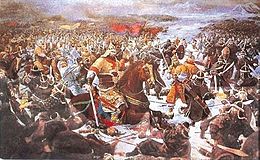
Back Batalla de Salsu Catalan Μάχη του Σάλσου Greek Battle of Salsu English Batalla de Salsu Spanish نبرد سالسو Persian Salsun taistelu Finnish Սալսուի ճակատամարտ Armenian Pertempuran Salsu ID Battaglia di Salsu Italian 살수 대첩 Korean
Bataille de Salsu
| Date | 612 |
|---|---|
| Lieu | Rivière Salsu, Corée |
| Issue | Victoire décisive du Koguryo, qui contribue à la chute de la Dynastie Sui |
| Koguryo Göktürk [1],[2],[3] | Dynastie Sui |
| Eulji Mundeok | Yu Zhongwen Yuwen Shu |
| environ 10 000 cavaliers | 305 000 [4],[5],[6],[7] |
| inconnues, mais modérées | 302 300 [5],[6],[7],[8] |
La bataille de Salsu (en coréen Hangeul : 살수대첩 Hanja: 薩水之戰 Romanisation révisée : Salsu Daecheop McCune-Reischauer : Salsu Taech'ŏp) est un affrontement entre les troupes de la dynastie chinoise des Sui et celle du royaume coréen de Koguryo, qui s'est déroulée en l'an 612. Elle se déroule pendant la seconde campagne de la guerre qui oppose ces deux pays et se conclut par une victoire décisive du royaume coréen, lorsque sa cavalerie poursuit, attaque et bat l'armée chinoise près de la rivière Salsu.
- ↑ Kuzey Hanedanlar Tarihi, Cilt 87 Sf.673
- ↑ Ssu-ma Kuang, Tzu chih t'ung chien, Cilt 189 Sf 463
- ↑ Suei Shu. 81. sf. 1865
- ↑ « The Three Kingdoms », National Assembly of South Korea (consulté le )
- Livre des Sui, Vol. 60.
- Ki-Baik Lee, A New History of Korea, Cambridge, Massachusetts, Harvard University Press, (ISBN 0-674-61576-X), p. 47 "Koguryŏ was the first to open hostilities, with a bold assault across the Liao River against Liao-hsi, in 598. The Sui emperor, Wen Ti, launched a retaliatory attack on Koguryŏ but met with reverses and turned back in mid-course. Yang Ti, the next Sui emperor, proceeded in 612 to mount an invasion of unprecedented magnitude, marshalling a huge force said to number over a million men. And when his armies failed to take Liao-tung Fortress (modern Liao-yang), the anchor of Koguryŏ's first line of defense, he had a nearly a third of his forces, some 300,000 strong, break off the battle there and strike directly at the Koguryŏ capital of P'yŏngyang. But the Sui army was lured into a trap by the famed Koguryŏ commander Ŭlchi Mundŏk, and suffered a calamitous defeat at the Salsu (Ch'ŏngch'ŏn) River. It is said that only 2,700 of the 300,000 Sui soldiers who had crossed the Yalu survived to find their way back, and the Sui emperor now lifted the siege of Liao-tung Fortress and withdrew his forces to China proper. Yang Ti continued to send his armies against Koguryŏ but again without success, and before long his war-weakened empire crumbled."
- Andrew C. Nahm, A Panorama of 5000 Years : Korean History, Séoul, Hollym International Corporation, , Second revised éd. (ISBN 0-930878-68-X), p. 18 "China, which had been split into many states since the early 3rd century, was reunified by the Sui dynasty at the end of the 6th century. Soon after that, Sui China mobilized a large number of troops and launched war against Koguryŏ. However, the people of Koguryŏ were united and they were able to repel the Chinese aggressors. In 612, Sui troops invaded Korea again, but Koguryŏ forces fought bravely and destroyed Sui troops everywhere. General Ŭlchi Mundŏk of Koguryŏ completely wiped out some 300,000 Sui troops which came across the Yalu River in the battles near the Salsu River (now Ch'ŏngch'ŏn River) with his ingenious military tactics. Only 2,700 Sui troops were able to flee from Korea. The Sui dynasty, which wasted so much energy and manpower in aggressive wars against Koguryŏ, fell in 618."
- ↑ "Battle of Salsu", Encyclopædia Britannica Korean Edition
